Linfeng Li
Mixed-R1: Unified Reward Perspective For Reasoning Capability in Multimodal Large Language Models
May 30, 2025Abstract:Recent works on large language models (LLMs) have successfully demonstrated the emergence of reasoning capabilities via reinforcement learning (RL). Although recent efforts leverage group relative policy optimization (GRPO) for MLLMs post-training, they constantly explore one specific aspect, such as grounding tasks, math problems, or chart analysis. There are no works that can leverage multi-source MLLM tasks for stable reinforcement learning. In this work, we present a unified perspective to solve this problem. We present Mixed-R1, a unified yet straightforward framework that contains a mixed reward function design (Mixed-Reward) and a mixed post-training dataset (Mixed-45K). We first design a data engine to select high-quality examples to build the Mixed-45K post-training dataset. Then, we present a Mixed-Reward design, which contains various reward functions for various MLLM tasks. In particular, it has four different reward functions: matching reward for binary answer or multiple-choice problems, chart reward for chart-aware datasets, IoU reward for grounding problems, and open-ended reward for long-form text responses such as caption datasets. To handle the various long-form text content, we propose a new open-ended reward named Bidirectional Max-Average Similarity (BMAS) by leveraging tokenizer embedding matching between the generated response and the ground truth. Extensive experiments show the effectiveness of our proposed method on various MLLMs, including Qwen2.5-VL and Intern-VL on various sizes. Our dataset and model are available at https://github.com/xushilin1/mixed-r1.
DORAEMON: Decentralized Ontology-aware Reliable Agent with Enhanced Memory Oriented Navigation
May 29, 2025Abstract:Adaptive navigation in unfamiliar environments is crucial for household service robots but remains challenging due to the need for both low-level path planning and high-level scene understanding. While recent vision-language model (VLM) based zero-shot approaches reduce dependence on prior maps and scene-specific training data, they face significant limitations: spatiotemporal discontinuity from discrete observations, unstructured memory representations, and insufficient task understanding leading to navigation failures. We propose DORAEMON (Decentralized Ontology-aware Reliable Agent with Enhanced Memory Oriented Navigation), a novel cognitive-inspired framework consisting of Ventral and Dorsal Streams that mimics human navigation capabilities. The Dorsal Stream implements the Hierarchical Semantic-Spatial Fusion and Topology Map to handle spatiotemporal discontinuities, while the Ventral Stream combines RAG-VLM and Policy-VLM to improve decision-making. Our approach also develops Nav-Ensurance to ensure navigation safety and efficiency. We evaluate DORAEMON on the HM3D, MP3D, and GOAT datasets, where it achieves state-of-the-art performance on both success rate (SR) and success weighted by path length (SPL) metrics, significantly outperforming existing methods. We also introduce a new evaluation metric (AORI) to assess navigation intelligence better. Comprehensive experiments demonstrate DORAEMON's effectiveness in zero-shot autonomous navigation without requiring prior map building or pre-training.
An Empirical Study of GPT-4o Image Generation Capabilities
Apr 08, 2025Abstract:The landscape of image generation has rapidly evolved, from early GAN-based approaches to diffusion models and, most recently, to unified generative architectures that seek to bridge understanding and generation tasks. Recent advances, especially the GPT-4o, have demonstrated the feasibility of high-fidelity multimodal generation, their architectural design remains mysterious and unpublished. This prompts the question of whether image and text generation have already been successfully integrated into a unified framework for those methods. In this work, we conduct an empirical study of GPT-4o's image generation capabilities, benchmarking it against leading open-source and commercial models. Our evaluation covers four main categories, including text-to-image, image-to-image, image-to-3D, and image-to-X generation, with more than 20 tasks. Our analysis highlights the strengths and limitations of GPT-4o under various settings, and situates it within the broader evolution of generative modeling. Through this investigation, we identify promising directions for future unified generative models, emphasizing the role of architectural design and data scaling.
Advancing Fine-Grained Visual Understanding with Multi-Scale Alignment in Multi-Modal Models
Nov 14, 2024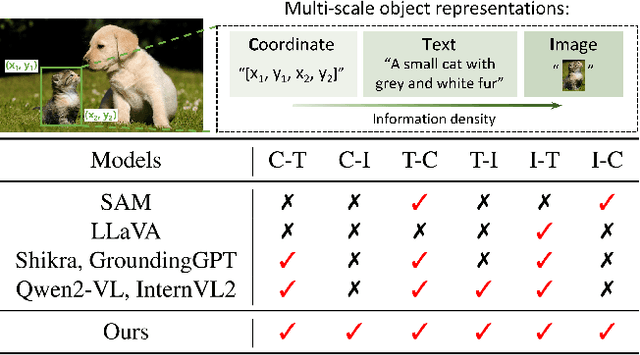
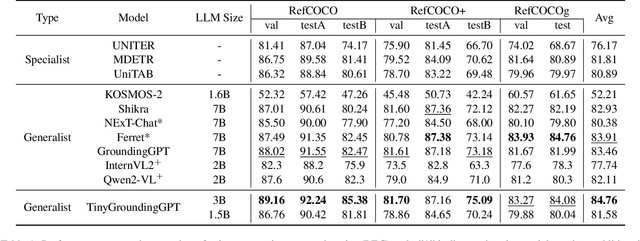
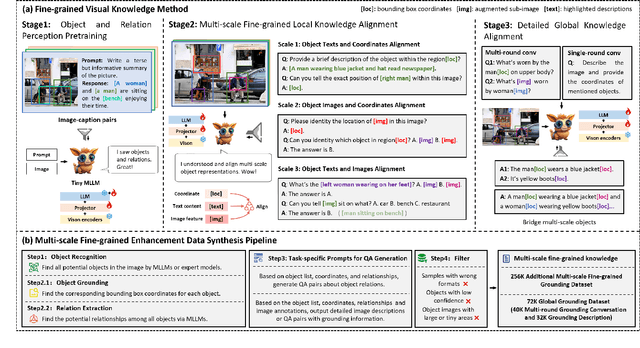
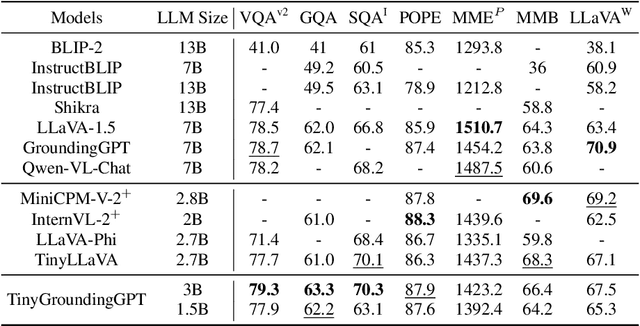
Abstract:Multi-modal large language models (MLLMs) have achieved remarkable success in fine-grained visual understanding across a range of tasks. However, they often encounter significant challenges due to inadequate alignment for fine-grained knowledge, which restricts their ability to accurately capture local details and attain a comprehensive global perception. While recent advancements have focused on aligning object expressions with grounding information, they typically lack explicit integration of object images, which contain affluent information beyond mere texts or coordinates. To bridge this gap, we introduce a novel fine-grained visual knowledge alignment method that effectively aligns and integrates multi-scale knowledge of objects, including texts, coordinates, and images. This innovative method is underpinned by our multi-scale fine-grained enhancement data synthesis pipeline, which provides over 300K essential training data to enhance alignment and improve overall performance. Furthermore, we present TinyGroundingGPT, a series of compact models optimized for high-level alignments. With a scale of approximately 3B parameters, TinyGroundingGPT achieves outstanding results in grounding tasks while delivering performance comparable to larger MLLMs in complex visual scenarios.
Stable Object Placement Under Geometric Uncertainty via Differentiable Contact Dynamics
Sep 26, 2024Abstract:From serving a cup of coffee to carefully rearranging delicate items, stable object placement is a crucial skill for future robots. This skill is challenging due to the required accuracy, which is difficult to achieve under geometric uncertainty. We leverage differentiable contact dynamics to develop a principled method for stable object placement under geometric uncertainty. We estimate the geometric uncertainty by minimizing the discrepancy between the force-torque sensor readings and the model predictions through gradient descent. We further keep track of a belief over multiple possible geometric parameters to mitigate the gradient-based method's sensitivity to the initialization. We verify our approach in the real world on various geometric uncertainties, including the in-hand pose uncertainty of the grasped object, the object's shape uncertainty, and the environment's shape uncertainty.
Differentiable Particles for General-Purpose Deformable Object Manipulation
May 02, 2024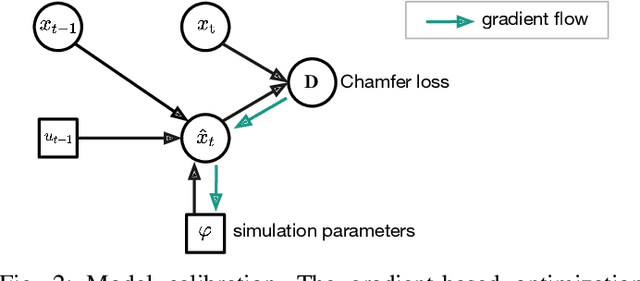
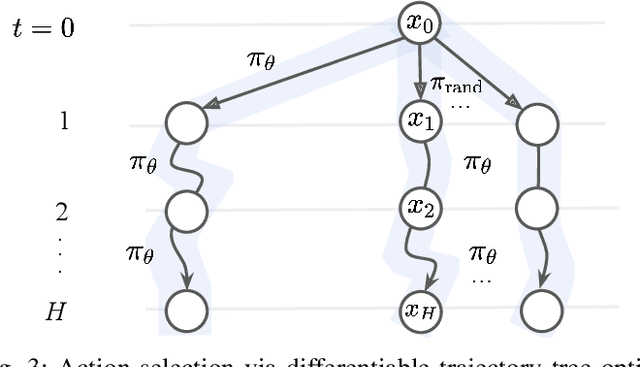
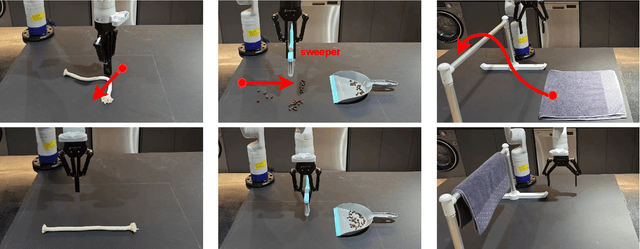

Abstract:Deformable object manipulation is a long-standing challenge in robotics. While existing approaches often focus narrowly on a specific type of object, we seek a general-purpose algorithm, capable of manipulating many different types of objects: beans, rope, cloth, liquid, . . . . One key difficulty is a suitable representation, rich enough to capture object shape, dynamics for manipulation and yet simple enough to be acquired effectively from sensor data. Specifically, we propose Differentiable Particles (DiPac), a new algorithm for deformable object manipulation. DiPac represents a deformable object as a set of particles and uses a differentiable particle dynamics simulator to reason about robot manipulation. To find the best manipulation action, DiPac combines learning, planning, and trajectory optimization through differentiable trajectory tree optimization. Differentiable dynamics provides significant benefits and enable DiPac to (i) estimate the dynamics parameters efficiently, thereby narrowing the sim-to-real gap, and (ii) choose the best action by backpropagating the gradient along sampled trajectories. Both simulation and real-robot experiments show promising results. DiPac handles a variety of object types. By combining planning and learning, DiPac outperforms both pure model-based planning methods and pure data-driven learning methods. In addition, DiPac is robust and adapts to changes in dynamics, thereby enabling the transfer of an expert policy from one object to another with different physical properties, e.g., from a rigid rod to a deformable rope.
Rethinking Object Saliency Ranking: A Novel Whole-flow Processing Paradigm
Dec 06, 2023



Abstract:Existing salient object detection methods are capable of predicting binary maps that highlight visually salient regions. However, these methods are limited in their ability to differentiate the relative importance of multiple objects and the relationships among them, which can lead to errors and reduced accuracy in downstream tasks that depend on the relative importance of multiple objects. To conquer, this paper proposes a new paradigm for saliency ranking, which aims to completely focus on ranking salient objects by their "importance order". While previous works have shown promising performance, they still face ill-posed problems. First, the saliency ranking ground truth (GT) orders generation methods are unreasonable since determining the correct ranking order is not well-defined, resulting in false alarms. Second, training a ranking model remains challenging because most saliency ranking methods follow the multi-task paradigm, leading to conflicts and trade-offs among different tasks. Third, existing regression-based saliency ranking methods are complex for saliency ranking models due to their reliance on instance mask-based saliency ranking orders. These methods require a significant amount of data to perform accurately and can be challenging to implement effectively. To solve these problems, this paper conducts an in-depth analysis of the causes and proposes a whole-flow processing paradigm of saliency ranking task from the perspective of "GT data generation", "network structure design" and "training protocol". The proposed approach outperforms existing state-of-the-art methods on the widely-used SALICON set, as demonstrated by extensive experiments with fair and reasonable comparisons. The saliency ranking task is still in its infancy, and our proposed unified framework can serve as a fundamental strategy to guide future work.
COACH: Cooperative Robot Teaching
Feb 13, 2023



Abstract:Knowledge and skills can transfer from human teachers to human students. However, such direct transfer is often not scalable for physical tasks, as they require one-to-one interaction, and human teachers are not available in sufficient numbers. Machine learning enables robots to become experts and play the role of teachers to help in this situation. In this work, we formalize cooperative robot teaching as a Markov game, consisting of four key elements: the target task, the student model, the teacher model, and the interactive teaching-learning process. Under a moderate assumption, the Markov game reduces to a partially observable Markov decision process, with an efficient approximate solution. We illustrate our approach on two cooperative tasks, one in a simulated video game and one with a real robot.
Benchmarking Deformable Object Manipulation with Differentiable Physics
Oct 24, 2022Abstract:Deformable Object Manipulation (DOM) is of significant importance to both daily and industrial applications. Recent successes in differentiable physics simulators allow learning algorithms to train a policy with analytic gradients through environment dynamics, which significantly facilitates the development of DOM algorithms. However, existing DOM benchmarks are either single-object-based or non-differentiable. This leaves the questions of 1) how a task-specific algorithm performs on other tasks and 2) how a differentiable-physics-based algorithm compares with the non-differentiable ones in general. In this work, we present DaXBench, a differentiable DOM benchmark with a wide object and task coverage. DaXBench includes 9 challenging high-fidelity simulated tasks, covering rope, cloth, and liquid manipulation with various difficulty levels. To better understand the performance of general algorithms on different DOM tasks, we conduct comprehensive experiments over representative DOM methods, ranging from planning to imitation learning and reinforcement learning. In addition, we provide careful empirical studies of existing decision-making algorithms based on differentiable physics, and discuss their limitations, as well as potential future directions.
CBLUE: A Chinese Biomedical Language Understanding Evaluation Benchmark
Jul 06, 2021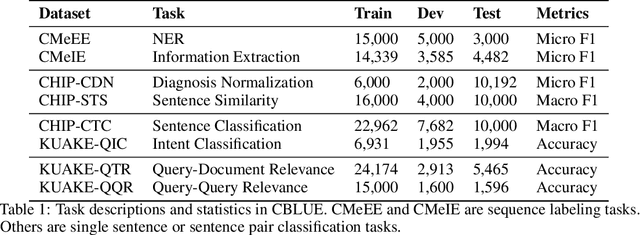
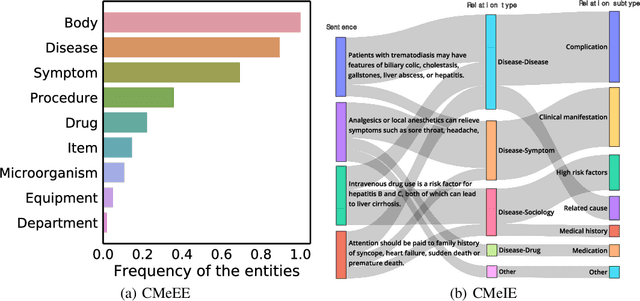
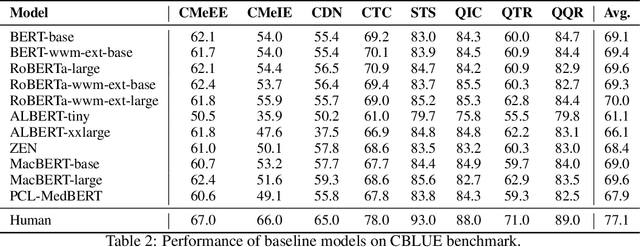

Abstract:Artificial Intelligence (AI), along with the recent progress in biomedical language understanding, is gradually changing medical practice. With the development of biomedical language understanding benchmarks, AI applications are widely used in the medical field. However, most benchmarks are limited to English, which makes it challenging to replicate many of the successes in English for other languages. To facilitate research in this direction, we collect real-world biomedical data and present the first Chinese Biomedical Language Understanding Evaluation (CBLUE) benchmark: a collection of natural language understanding tasks including named entity recognition, information extraction, clinical diagnosis normalization, single-sentence/sentence-pair classification, and an associated online platform for model evaluation, comparison, and analysis. To establish evaluation on these tasks, we report empirical results with the current 11 pre-trained Chinese models, and experimental results show that state-of-the-art neural models perform by far worse than the human ceiling. Our benchmark is released at \url{https://tianchi.aliyun.com/dataset/dataDetail?dataId=95414&lang=en-us}.
 Add to Chrome
Add to Chrome Add to Firefox
Add to Firefox Add to Edge
Add to Edge